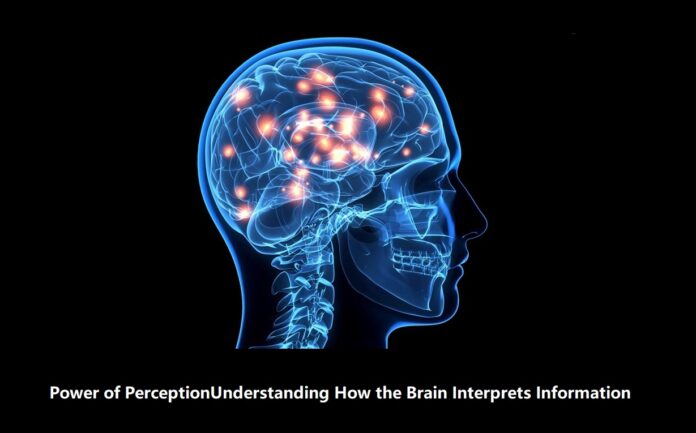Perception is the process by which we interpret and organize the sensory information we receive from the world around us. The power of perception dramatically influences our behavior and decision-making, shaping how we interact with others and the environment. Understanding how the brain processes information is then a key factor in explaining how individuals comprehend and react to stimuli differently.
Perception is not only a conscious process but also an unconscious one, and it can be significantly affected by cognitive biases and individual experiences.
Thus, having a better grasp of how our brains perceive information is essential in expanding our knowledge of human behavior and decision-making.
From evaluating the quality of information presented in the media to understanding the reasons behind others’ actions, perception plays a vital role in shaping our understanding of the world we live in.
In this blog post, we will explore the power of perception and how it influences the way we interact with the world.
Perception and the Brain
Perception and the brain are closely intertwined, as the brain is responsible for interpreting and making sense of the information received through our five senses.
Our past experiences, cultural backgrounds, emotions, and cognitive processes influence the way we perceive the world around us.
Research has shown that the brain can be tricked into perceiving things that are not actually there, a phenomenon known as visual illusions.
Moreover, external factors, such as social norms and expectations, can influence our perception. It is crucial to understand how perception works in order to process and interpret information accurately and make informed decisions.
By studying perception and the brain, researchers have been able to gain insight into how we process information and how disorders such as schizophrenia and autism affect perception.
The Role of Sensory Input in Perceptual Processing
Our brains receive sensory input through our five senses: sight, hearing, touch, taste, and smell. This information is then processed in different areas of the brain to create a complete perception of the world around us.
However, the interpretation of sensory input can be affected by a variety of factors, including environmental context, past experiences, and individual differences in perception.
Thus, our perceptions are not simply a direct result of sensory input but are shaped by complex cognitive and neural processes.
The Impact of Attention and Memory on Perception
The human brain constantly receives and processes vast amounts of information from the environment. However, not all of this information is processed equally.
In fact, the brain’s attentional and mnemonic systems are critical for selecting what information is relevant and what is not.
The attentional system actively filters out irrelevant stimuli while emphasizing essential signals, and the mnemonic system is responsible for the encoding and long-term storage of memories.
The combined impact of these systems on perception is profound, affecting not only what is seen but how it is interpreted and ultimately remembered.
Moreover, their role in perception is not limited to conscious awareness – attention and memory also influence the subconscious processing of sensory information.
How Emotions Influence Perception
Emotions are a critical component of perception, and they play a vital role in how the brain interprets the world around us.
For example, studies have shown that people in a positive emotional state are more likely to perceive gray images as bright and colorful.
In contrast, those in a negative emotional state perceive the same images as dull and lifeless.
Similarly, research has demonstrated that our emotional state can influence our perception of other people’s faces, leading us to be more empathetic and understanding of those in a positive emotional state and more judgmental and critical of those in a negative emotional state.
Social Influences on Perception
As social beings, we are constantly exposed to various social cues that can influence our perception of the world around us.
These cues can come from various sources, such as cultural norms, peer pressure, and social media. Influences from such sources can determine how we interpret and react to the information we receive.
For instance, cultural norms can influence how we perceive specific colors, while peer pressure can impact our food choices. The widespread use of social media can also influence our worldview by exposing us to certain narratives and ideologies.
Exploring the Limits of Human Perception

The human brain has the incredible ability to interpret and process vast amounts of information constantly. However, there are limits to what our brain can perceive and process.
Scientists and researchers have explored these limits through various experiments, leading to a better understanding of human perception.
These experiments have shown that our perception of time, sound, and even color can be manipulated and influenced.
For example, some studies suggest that humans can only perceive around 30 images per second, leading to the creation of the standard 30 frames per second in video production.
Additionally, the concept of augmented reality and virtual reality heavily depends on the brain’s interpretation of information and our visual and auditory perception.
Further exploration of the limits of human perception can lead to groundbreaking developments in various industries, from gaming to healthcare.
Applications for Applied Psychology
Applied psychology has numerous applications across various fields and industries. The study of how the brain interprets information offers insight into human behavior, decision-making, and problem-solving.
Eight key applications of applied psychology include clinical psychology, forensic psychology, educational psychology, sports psychology, industrial-organizational psychology, health psychology, counseling psychology, and social psychology.
In clinical psychology, for instance, therapists use theories of perception to help clients understand and manage their thoughts, feelings, and behaviors.
Forensic psychologists apply principles of perception to help solve crimes by analyzing witness testimony and investigating psychological factors that may have contributed to criminal behavior.
Educational psychologists use the science of perception to develop effective teaching strategies for learners of all ages.
The power of perception is evident in applied psychology, as professionals apply their knowledge to improve the well-being of individuals and communities.
Key Takeaways
- Perception is how we interpret and organize sensory information from the world around us.
- Perception significantly influences behavior and decision-making, shaping how we interact with others and the environment.
- The brain processes information to make sense of sensory input, which is affected by cognitive biases and individual experiences.
- Understanding perception is essential to expand knowledge of human behavior and decision-making, from media evaluation to understanding others’ actions.
- Perception and the brain are closely intertwined, and past experiences, cultural backgrounds, emotions, and cognitive processes influence perception.
- Sensory input is received through our five senses and processed in different brain areas to create a complete perception of the world around us.
- Attention and memory are vital in selecting relevant information and how it is interpreted and remembered.
- Emotions are a critical perception component and can influence how the brain interprets the world around us.
- Social cues, such as cultural norms, peer pressure, and social media, can influence how we interpret and react to information.
- Experiments have explored the limits of human perception, leading to a better understanding of human perception and its applications in various industries.
- Applied psychology uses principles of perception to improve well-being, such as clinical psychology, forensic psychology, educational psychology, sports psychology, industrial-organizational psychology, health psychology, counseling psychology, and social psychology.
Conclusion
The way the brain interprets information is complex and multifaceted. Perception is not just a passive process but an active and dynamic one that is influenced by various factors. Understanding perception’s power can help us better understand the world around us and how our brains function.
By being aware of the biases and limitations of perception, we can make more informed decisions and interact with others more effectively. The study of perception is still an ongoing area of research, and there is still much to learn about the fascinating ways in which our brain processes and interprets information.
RELATED: Health Tips for Overall Well Being.




